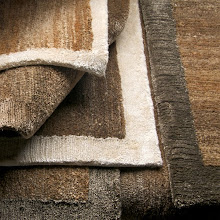It’s always been interesting to me that progessive “new” efforts to go green often mean simply returning to the way humans did things for centuries—and natural fiber and vegetable dyed rugs are a prime example of this.
While they have been touted as a way to make sure you’re buying an eco-friendly rug, vegetable dyes are by no means some new, green alternative. In fact, until the middle of the 19th century, natural dyed rugs were the only ones available. It wasn’t until synthetic dyes were invented in 1856 that centuries of tradition using vegetable dyes seemed to be tossed aside in favor of chemical dyes.
However, switching to the use of chemical dyes did not come without consequences. The environmental and health implications of using the chemical based dyes are significant. The metals in imported synthetic dyes are carried downstream from Kathmandu through thousands of miles of Indian rivers, potentially affecting millions of people.
Dozens of carpet dyers are also known to have suffered acute health problems from contact with the synthetic dyes. It is estimated that the Nepal carpet industry employs between 100,000 and 300,000 people, many of whom come into contact with raw dyestuffs regularly and who can be expected to have chronic, if not acute, reactions to the chemicals.
Natural dyes are made from plants, insects, and minerals. In Nepal and Tibet, most of the natural dyes are collected in the wild from sources such as oak tree galls, larkspur, woad, indigo, madder, and cochineal. A practice that not only is much better for the environment and thousands of people, but could also benefit Nepal weavers economically. The impact of diverting the tens of millions of dollars currently paid to European dye producers to Nepal farmers (who harvest materials to be used in the vegetable dyes) would be significant.
If that’s not enough to convince you to buy a vegetable dye rug, than maybe knowing rugs using vegtable dyes are also longer-lasting and higher quality. Distinguishing vegetable dye rugs from synthetic dye rugs can often be done with the naked eye.
Synthetic dyes permeate the fiber evenly; natural dyes are absorbed in a graduated pattern. Synthetic dyes fade in natural sunlight and, given enough time, disappear almost altogether. Natural dyes only soften or mellow in sunlight, no matter how prolonged the exposure.
EcoFiber Custom Rugs offers a variety of beautiful, natural vegetable dye colors—including indigo hues, honey tones, neutrals and verdant.
>>Learn more about EcoFiber Custom Rugs’ vegetable dye colors




No comments:
Post a Comment